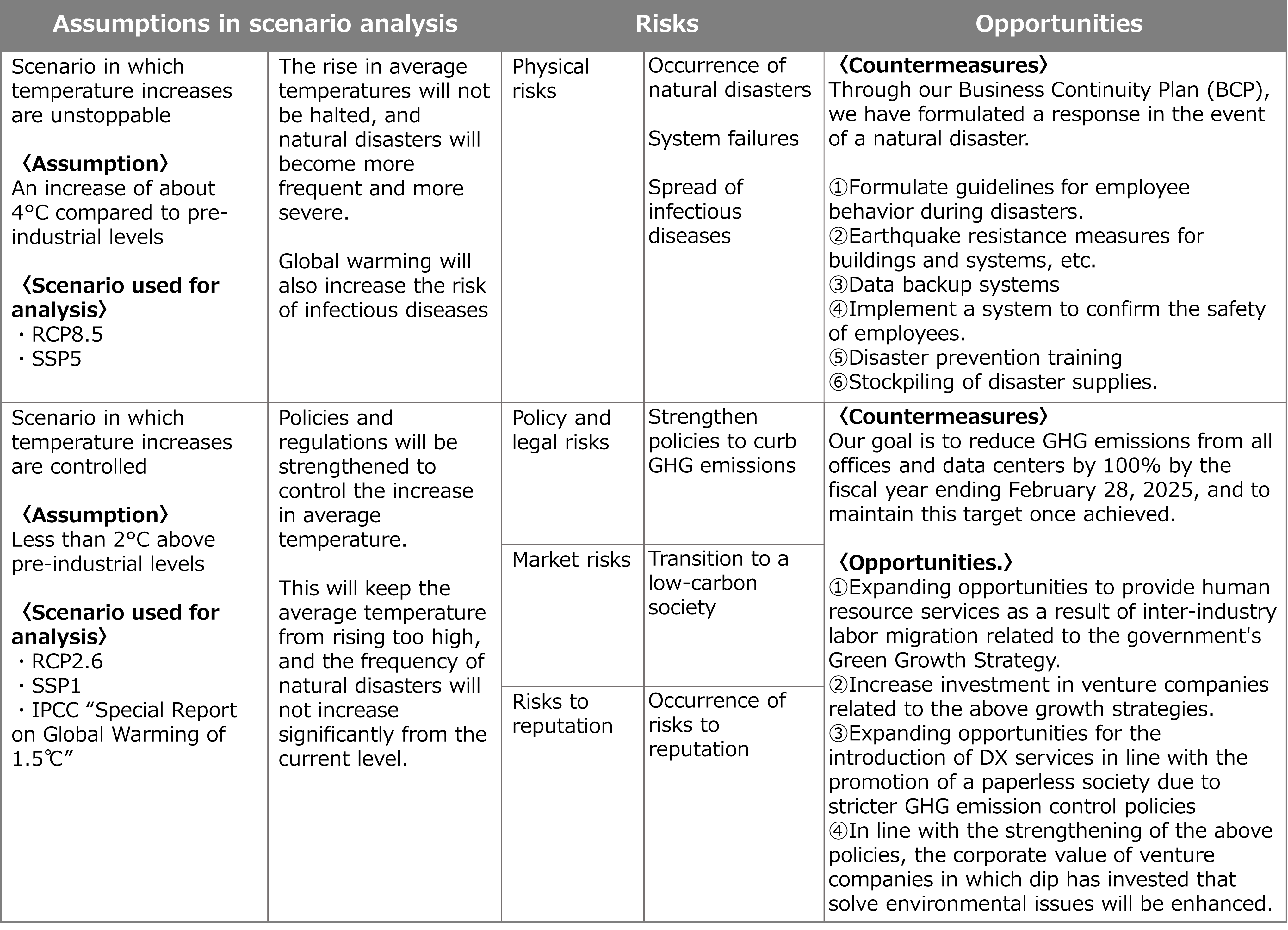
Climate Change Initiatives
Climate Change Initiatives
Climate Change Initiatives
Climate change not only affects the entire fabric of human existence, but also poses a major threat to equitable economic growth, poverty reduction, and human security, and is an important issue that the entire world must work to solve. In recent years, phenomena that are thought to be caused by the adverse effects of climate change have been reported in many areas, and are expected to become a serious problem in various regions and fields in the future. We consider the issue of climate change to be an important management issue and have been working to understand its impact and build a system to manage the risks.
Addressing the recommendations of the Task Force on Climate-related Financial Disclosures (TCFD)
In October 2021, dip expressed its support for the TCFD recommendations. In December of the same year, dip made disclosures in line with the disclosure framework recommended by TCFD (governance, strategy, risk management, indicators and targets related to climate change risks and opportunities). We will continue to consider expanding the content of our disclosures and aim to further strengthen our governance and business strategies related to climate change based on the results of our scenario analysis.
Disclosure content in line with TCFD recommendations
Dip has organized its approach to climate change according to each of the four disclosure fundamentals recommended by TCFD: governance, strategy, risk management, and indicators and targets.
| Ⅰ Governance | ||
|---|---|---|
| 1 | Describe the board's oversight framework of climate-related risks and opportunities. | ▶home page ▶System for the promotion of sustainability |
| 2 | Describe management’s role in assessing and managing climate-related risks and opportunities. | ▶home page ▶System for the promotion of sustainability |
| Ⅱ Strategies | ||
| 1 | Describe the climate-related risks and opportunities the organization has identified over the short, medium, and long term. | ▶home page |
| 2 | Describe the impact of climate-related risks and opportunities on the organization's businesses, strategy, and financial planning. | ▶home page |
| 3 | Describe the resilience of the organization's strategy, taking into consideration different climate-related scenarios, including a 2°C or lower scenario. | ▶home page |
| Ⅲ Risk Management | ||
| 1 | Describe the organization's processes for identifying and assessing climate-related risks. | ▶home page |
| 2 | Describe the organization's processes for managing climate-related risks. | ▶home page |
| 3 | Describe how processes for identifying, assessing, and managing climate-related risks are integrated into the organization's overall risk management. | ▶home page |
| Ⅳ Metrics and Targets | ||
| 1 | Describe the climate-related risks and opportunities the organization has identified over the short, medium, and long term. | ▶home page |
| 2 | Disclose the metrics used by the organization to assess climate related risks and opportunities in line with its strategy and risk management process. | ▶Environmental data |
| 3 | Disclose Scope1, Scope2, and, if appropriate, Scope3 greenhouse gas (GHG) emissions, and the related risks. | ▶home page ▶Environmental data |
Ⅰ Governance for Climate Change
Dip's Board of Directors deliberates and resolves on environmental policies and important related matters, including climate change issues. The Sustainability Promotion Committee, chaired by the COO and consisting of all executive officers, identifies risks and opportunities related to climate change, sets measures and targets, and evaluates progress. In addition, the Sustainability Promotion Committee is responsible for promoting measures related to climate change, and the Board of Directors oversees the implementation of these measures.
The Board of Directors receives regular reports on the risks and opportunities related to climate change and the progress of response measures, supervises the progress toward targets, and directs actions as appropriate.
In formulating sustainability-related measures, we consider not only proposals from the Sustainability Promotion Committee, but also ideas from employees and others.
Ⅱ Business implications of climate-related risks and opportunities
At dip, the Sustainability Promotion Committee reviews, evaluates and analyzes climate change risks and opportunities. This information is reflected in the annual review of the risk map and is integrated into the company-wide risk management.
Through the same committee, measures to deal with identified risks are discussed and reported to the Board of Directors.

Ⅲ Managing climate-related risks
At dip, the Sustainability Promotion Committee reviews, evaluates and analyzes climate change risks and opportunities. This information is reflected in the annual review of the risk map and is integrated into the company-wide risk management.
In addition, the committee examines countermeasures for identified risks and reports to the Board of Directors.
Ⅳ Indicators and targets
Dip has set a goal of reducing GHG emissions from all offices (*1) and data centers by 100% by the fiscal year ending February 28, 2025.
In September 2021, we converted virtually all electricity used at our head office to renewable energy sources. During the fiscal year ending February 28, 2023, we will gradually switch to renewable energy sources for electricity used at offices other than the head office.
※1 Scope 1+2 at all offices
